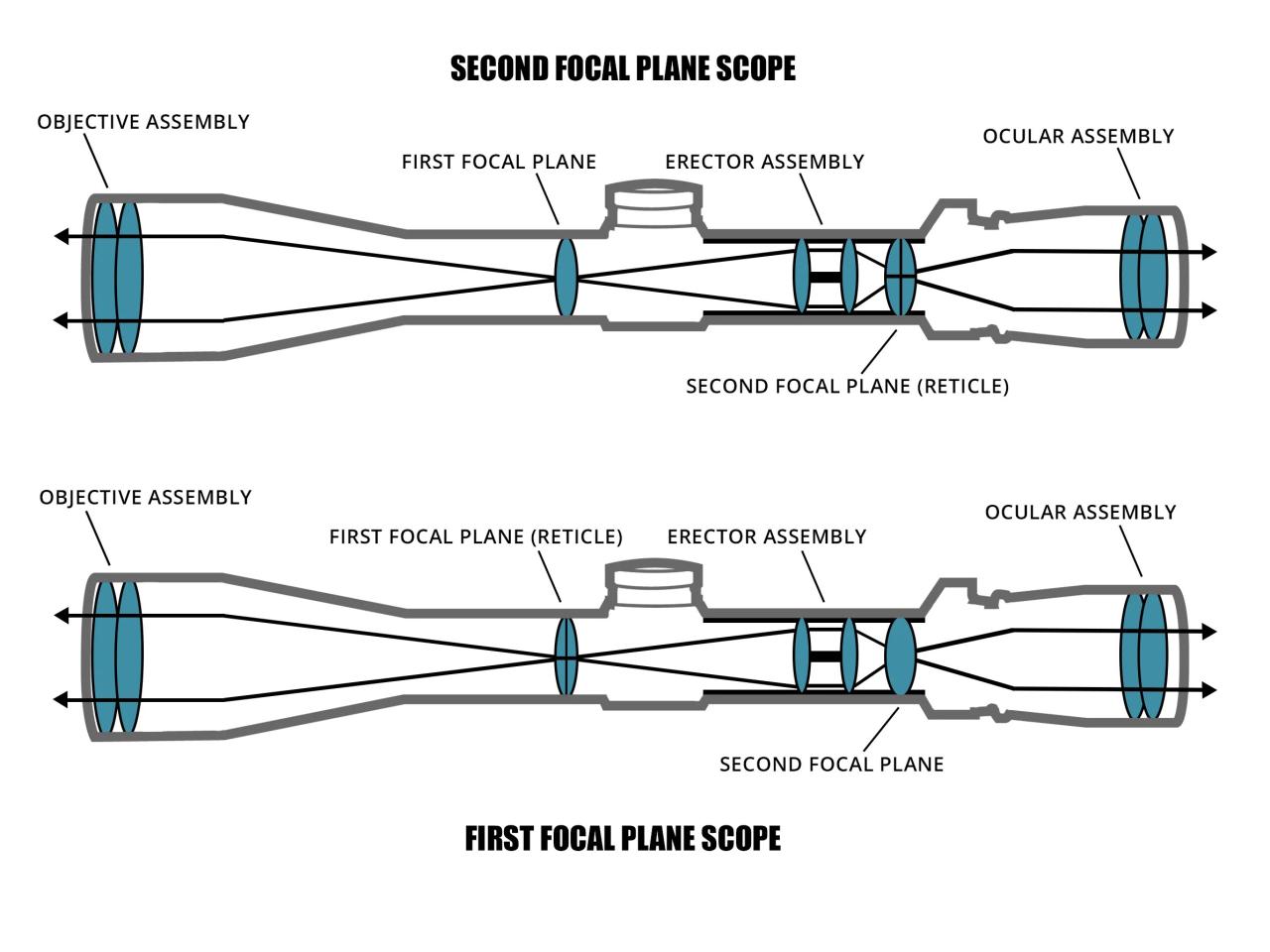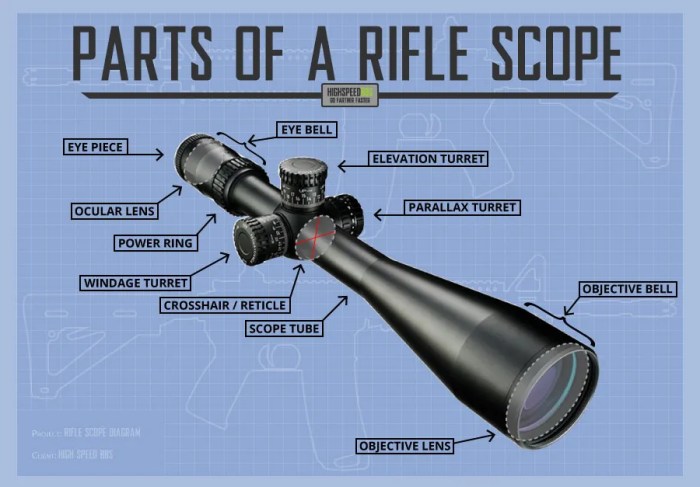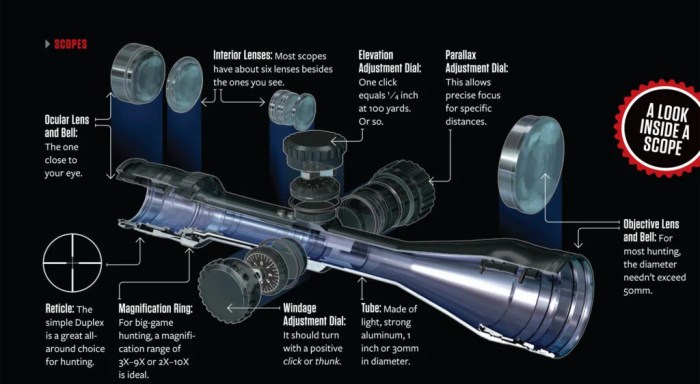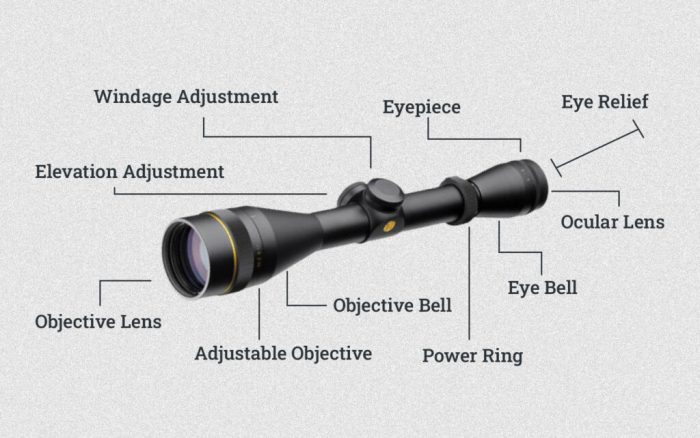Embark on a journey into the intricate anatomy of a rifle scope, where precision meets accuracy. This comprehensive guide unveils the essential components and their functions, providing a clear understanding of this crucial firearm accessory.
From the objective lens to the reticle, each element plays a vital role in enhancing your shooting experience. Dive into the fascinating world of rifle scopes and discover the secrets that unlock their remarkable capabilities.
Anatomy of a Rifle Scope
A rifle scope is an optical device that is mounted on a rifle to provide the shooter with a magnified view of the target. It consists of several components, each of which plays a specific role in the overall function of the scope.
Components of a Rifle Scope
- Objective Lens:The objective lens is the large lens at the front of the scope. It collects light from the target and focuses it on the reticle.
- Erector Lens:The erector lens is located behind the objective lens. It corrects the image that is produced by the objective lens and flips it so that it is upright.
- Reticle:The reticle is a set of crosshairs or other markings that are used to aim the rifle. It is located in the focal plane of the scope, which means that it remains the same size regardless of the magnification.
- Ocular Lens:The ocular lens is the small lens at the back of the scope. It magnifies the image that is produced by the erector lens and projects it onto the shooter’s retina.
- Adjustment Knobs:The adjustment knobs are used to adjust the windage and elevation of the scope. The windage knob adjusts the scope horizontally, while the elevation knob adjusts it vertically.
- Tube:The tube is the housing that holds the lenses and other components of the scope. It is typically made of aluminum or steel.
Diagram of a Rifle Scope
[Insert detailed diagram of a rifle scope here]
Types of Rifle Scopes

Rifle scopes come in a variety of types, each designed for specific shooting applications. Understanding the different types of rifle scopes available will help you choose the best one for your needs.
The main types of rifle scopes include:
Fixed Power Scopes
Fixed power scopes offer a single, fixed magnification level. They are typically more compact and lightweight than variable power scopes, and they are often preferred for target shooting or other applications where a specific magnification level is desired.
- Advantages:Compact, lightweight, less expensive, simpler to use
- Disadvantages:Limited magnification range
- Examples:Nikon ProStaff 3-9×40, Leupold VX-3 4.5-14×50
Variable Power Scopes
Variable power scopes offer a range of magnification levels, allowing you to adjust the magnification to suit the shooting situation. They are more versatile than fixed power scopes, but they are also larger and heavier.
- Advantages:Versatile, wide magnification range
- Disadvantages:Larger, heavier, more expensive
- Examples:Vortex Viper PST Gen II 5-25×50, Nightforce ATACR 7-35×56
Red Dot Scopes
Red dot scopes are designed for fast target acquisition. They use a red dot as the aiming point, which is projected onto the lens. Red dot scopes are typically lightweight and compact, and they are often used for close-range shooting or for hunting moving targets.
- Advantages:Fast target acquisition, lightweight, compact
- Disadvantages:Limited magnification, not suitable for long-range shooting
- Examples:Aimpoint CompM5, EOTech XPS2
Holographic Weapon Sights
Holographic weapon sights (HWS) are similar to red dot scopes, but they use a holographic projection as the aiming point. This results in a clearer and brighter aiming point than a red dot scope, and it also allows for the use of a reticle with multiple aiming points.
- Advantages:Clear, bright aiming point, multiple aiming points
- Disadvantages:More expensive than red dot scopes, not as durable
- Examples:EOTech EXPS3, Aimpoint T2
Choosing the Right Rifle Scope

When selecting a rifle scope, several key factors must be considered to ensure optimal performance and suitability for your specific needs. These include the intended purpose of the rifle, the distance at which you will be shooting, and the level of magnification required.
Matching a Rifle Scope to a Specific Firearm
Matching a rifle scope to a specific firearm involves considering the following aspects:
Rifle Caliber
The caliber of the rifle determines the recoil generated, which can affect the durability and performance of the scope.
Rifle Action
The type of rifle action (e.g., bolt-action, semi-automatic) influences the mounting system required for the scope.
Rifle Rail
The rifle’s rail system (e.g., Picatinny, Weaver) dictates the type of scope mount needed.
Mounting a Rifle Scope: Anatomy Of A Rifle Scope

Mounting a rifle scope securely and precisely is crucial for accurate shooting. Several methods are available, each with its advantages and drawbacks.
The anatomy of a rifle scope encompasses various components, each contributing to the precise aiming and shooting experience. To enhance your understanding of this topic, consider exploring unit 4 session 7 letrs , where you can delve into further details about rifle scopes and their intricate mechanisms.
This resource provides valuable insights into the different parts of a rifle scope, their functions, and how they work together to ensure accuracy and precision in your shooting endeavors.
Ring Mounts
Ring mounts are the most common method of attaching a scope to a rifle. They consist of two separate rings that clamp around the scope tube and are secured to the rifle’s receiver or rail using screws. Ring mounts offer flexibility in scope placement and are relatively easy to install.
- Pros:Versatility, ease of installation, affordability.
- Cons:Can introduce alignment errors if not installed correctly, may not be suitable for all rifles.
Base and Ring Mounts
Base and ring mounts combine a one-piece base that attaches to the rifle’s receiver or rail with separate rings that clamp onto the scope tube. This design provides a more rigid and stable platform for the scope, reducing the risk of alignment issues.
- Pros:Increased stability, improved accuracy, less prone to alignment errors.
- Cons:More complex to install, may be more expensive.
Integral Mounts
Integral mounts are built into the rifle’s receiver or rail, eliminating the need for separate rings or bases. This design offers the highest level of stability and accuracy, but it is only available on certain rifle models.
- Pros:Excellent stability, no alignment issues, custom-fit to the rifle.
- Cons:Limited availability, may be more expensive.
Detailed Guide to Mounting a Rifle Scope
To mount a rifle scope using ring mounts, follow these steps:
- Clean the rifle’s receiver or rail and the scope tube with rubbing alcohol.
- Position the rings on the scope tube at the desired location, ensuring they are aligned correctly.
- Tighten the ring screws gradually and evenly to avoid overtightening and damaging the scope.
- Attach the rings to the receiver or rail using the provided screws.
- Verify the scope’s alignment by looking through it at a distant target.
Using a Rifle Scope

A rifle scope is an optical instrument that is mounted on a rifle to aid in aiming. It provides magnification, allowing the shooter to see the target more clearly, and it can also have other features such as a reticle, which can help the shooter to align the rifle with the target.
To use a rifle scope, the shooter first needs to mount it on the rifle. This is typically done using a set of scope rings or a scope mount. Once the scope is mounted, the shooter needs to adjust the magnification and the reticle so that they are appropriate for the shooting conditions.
Adjusting the Magnification, Anatomy of a rifle scope
The magnification of a rifle scope is measured in power. A scope with a magnification of 3x will make the target appear three times larger than it would with the naked eye. A scope with a magnification of 9x will make the target appear nine times larger.
The appropriate magnification for a rifle scope will depend on the shooting conditions. For shooting at long distances, a higher magnification will be necessary. For shooting at close distances, a lower magnification will be more appropriate.
Adjusting the Reticle
The reticle is a set of lines or dots that are etched into the lens of the rifle scope. The reticle helps the shooter to align the rifle with the target. There are many different types of reticles, each with its own advantages and disadvantages.
The most common type of reticle is the crosshair reticle. The crosshair reticle consists of two lines that intersect at the center of the lens. The horizontal line is called the “crosshair,” and the vertical line is called the “post.”
Tips and Techniques for Using a Rifle Scope Effectively
- Use a rifle scope that is appropriate for the shooting conditions.
- Adjust the magnification and the reticle so that they are appropriate for the shooting conditions.
- Practice shooting with the rifle scope until you are comfortable with it.
- Use a shooting rest to help you stabilize the rifle.
- Take your time and aim carefully.
Maintenance and Care of a Rifle Scope
Maintaining and caring for your rifle scope is crucial for ensuring its optimal performance and longevity. Regular cleaning and lubrication will prevent dirt, dust, and moisture from accumulating, which can affect the scope’s accuracy and reliability.
Importance of Regular Cleaning and Lubrication
Regular cleaning removes dirt, dust, and other debris that can accumulate on the lenses, turrets, and other components of the scope. This prevents scratches, fogging, and other issues that can impair the scope’s functionality. Lubrication helps to reduce friction between moving parts, ensuring smooth operation and extending the scope’s lifespan.
Step-by-Step Guide to Cleaning a Rifle Scope
Materials:* Soft, lint-free cloth
- Lens cleaning solution
- Soft-bristled brush
- Lubricating oil
Steps:
1. Remove the scope from the rifle
Loosen the mounting screws and carefully remove the scope from the rifle.
2. Inspect the scope
Examine the scope for any visible dirt, dust, or debris.
3. Clean the lenses
Use a soft, lint-free cloth dampened with lens cleaning solution to gently wipe the lenses clean. Avoid using paper towels or other abrasive materials.
4. Clean the turrets
Use a soft-bristled brush to remove any dirt or debris from the turrets. Be careful not to apply excessive pressure.
5. Lubricate the moving parts
Apply a small amount of lubricating oil to the moving parts of the scope, such as the turrets and focus knob.
6. Reinstall the scope
Carefully reinstall the scope on the rifle and tighten the mounting screws.
Commonly Asked Questions
What is the most important component of a rifle scope?
The objective lens, as it determines the amount of light entering the scope and directly impacts image brightness and clarity.
How do I choose the right rifle scope for my firearm?
Consider factors such as magnification, objective lens size, reticle type, and mounting system to ensure a perfect match.
What is the purpose of the reticle in a rifle scope?
The reticle provides a reference point for aiming and helps the shooter align the firearm with the target.